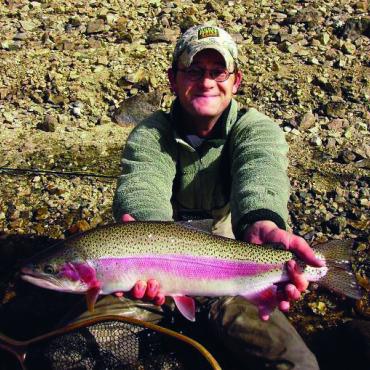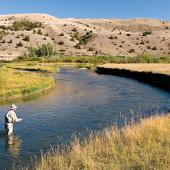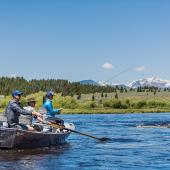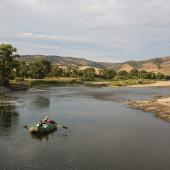Gallatin: A Wading Wonderland
Bozeman's most popular trout stream.
Named by Meriwether Lewis in 1805 in honor of then-Secretary of the Treasury Albert Gallatin, the Gallatin River flows approximately 120 miles from its source in Yellowstone National Park, to its confluence with the Madison and Jefferson in Three Forks. Despite threats from development pressures upstream and irrigation dewatering in the eponymous valley, this river remains a relatively healthy wild-trout fishery. Water types and fishing structure vary with the topography, elevation, and riparian habitat. Access is relatively easy up and down the river corridor, and it’s not too far from town. The Gallatin may not be the “perfect” trout fishing river, but it is very close.
Access
The upper section of the Gallatin has some of the easiest access of any river in Montana. Flowing northward through Gallatin Canyon, the river parallels and passes under Hwy. 191. The pull-outs, trailheads, and bridges are numerous. North of Gallatin Gateway, and downstream toward the river’s mouth, access becomes more limited, as most of the surrounding land is privately owned.
Flows
Flow levels on the Gallatin can vary drastically from season to season, and year to year. Flooding and high water are normally centered around the late spring and early summer months. Spring runoff flows can be dangerously high, swift, and have zero to marginal water clarity. In the average year, the Gallatin usually becomes fishable by middle to late June, but frequent showers can muddy it up quickly. These muddy spells may take a day or two to clear out.
When to Go
The Gallatin can be a very productive year-round fishery; however, late June to mid-July tend to produce the best dry-fly action. Due to the river’s highly accessible nature, the peak fishing season on the Gallatin can be a difficult time for an angler seeking solitude. The canyon area from Sage Creek to Spanish Creek sees a significant amount of pressure, and don’t be surprised if one or more “splash and giggle” flotillas come bobbing down your run. Schedule fishing times on this river during peak season to very early mornings or late evenings. “Shoulder seasons,” however, can be productive as well. Late winter, pre-runoff in the early spring, as well as late autumn can be better bets for those seeking a less-populated angling experience.
Fish
The Gallatin is home to brown, rainbow, brook, and cutthroat trout. The latter of the four occurs mainly in the stretch that flows through Yellowstone Park. This portion of the river has a few grayling as well. Native mountain whitefish are also found in the Gallatin for almost its entire length. Unfortunately, non-native northern pike have been discovered in the lowermost stretches of the river, but as of now, they don’t seem to be growing in population. The trout in this river tend to move if pressured heavily by anglers, high water temperature, or reduced stream flows. Be prepared to hike a lot to find less pressured water or more suitable habitat.
Row vs. Wade
The Gallatin is a wading angler’s wonderland. While it is a relatively easy river to navigate on foot, large boulders and plenty of algae may make a wading stick a necessity. While recreational floating is allowed on the entire river, it is illegal to fish from a boat throughout a good portion of it. This restriction covers the portion of the river from its source in Yellowstone Park to its confluence with the East Gallatin north of Belgrade. Float fishing is possible below this point, but don’t try it blind. Take several scouting trips in waders to be sure your craft can complete the journey. Low flows and limited launching points also make float fishing in this lower portion very difficult.
Regs
Like most large rivers east of the Continental Divide, the Gallatin is open to fishing year-round—at least in the section outside of Yellowstone Park. The area within the Park opens the Saturday of Memorial Day weekend and runs through October 31; a special Park license is needed to fish this section. Yellowstone fishing permits are available at most area fly shops and outdoor retailers. Outside the Park, general regulations apply, with a “no limit” exception on northern pike. For more information on state and federal regulations, go to fwp.mt.gov or nps.gov.
Getting There
The easiest access to the Gallatin is via Hwy. 191 southwest of Bozeman. There are no “secret spots” on the stretch since every access is visible from the highway. Generally, stay away from highly popular “after work” spots, and try to avoid weekends and holidays.
Some of the lower portions of the river can be accessed from the old frontage road between Belgrade and Three Forks. Respect private property, and since the Gallatin runs through many farms and ranches, always keep your feet wet to stay in compliance with Montana’s stream-access law.
Kurt Dehmer owns Durty Kurty’s Guide Service in Bozeman.














